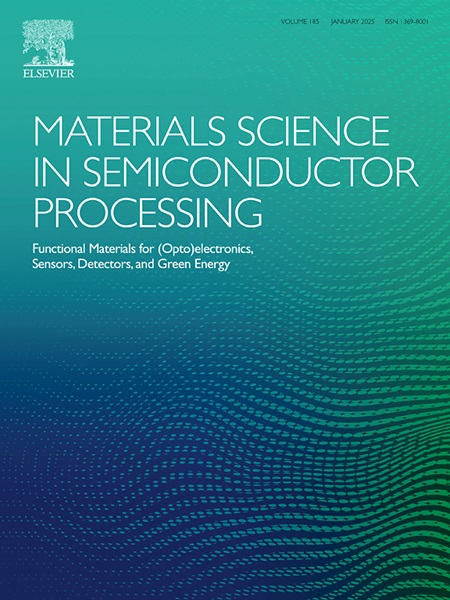Scalable growth of optically uniform MoWS2 alloys by sulfurization of ultrathin Mo/W stacks
IF 4.2
3区 工程技术
Q2 ENGINEERING, ELECTRICAL & ELECTRONIC
引用次数: 0
Abstract
Two-dimensional (2D) transition metal dichalcogenides (TMDs) ternary alloys, such as MoxW1-xS2, are very appealing for the possibility of continuously tuning their excitonic bandgap by the composition. However, the deposition of ultra-thin (monolayers or few-layers) alloys with laterally uniform composition on large area represents a main challenge of currently adopted synthesis methods. In this work, we demonstrated the growth of highly uniform Mo0.5W0.5S2 bi-layers on cm2 size SiO2/Si substrates by employing a simple and scalable approach, i.e. the sulfurization of a pre-deposited ultra-thin Mo/W stack at a temperature of 700 °C. Comparison of Mo(1.2 nm)/SiO2, W(1.2 nm)/SiO2, and Mo(1.2 nm)/W(1.2 nm)/SiO2 samples after identical sulfurization conditions revealed very different results, i.e. (i) a uniform monolayer (1L) MoS2 film, (ii) separated multilayer WS2 islands, and (iii) a uniform bilayer (2L) Mo0.5W0.5S2 film. This indicates how W surface diffusion and coalescence on SiO2 surface plays a main role in WS2 islands formation, whereas the reaction between S vapour with Mo films or Mo/W stacks represents the dominant mechanism for the formation of MoS2 and the MoWS2 alloy. Micro-photoluminescence (PL) mapping of the obtained 2L-Mo0.5W0.5S2 film showed an excellent uniformity of light emission on large area with an exciton peak at 1.97 eV, significantly blue-shifted with respect to PL emission of 1L-MoS2 at 1.86 eV. Such highly uniform optical properties make the grown MoWS2 alloy very promising for optoelectronic applications.
超薄Mo/W堆硫化法制备光均匀MoWS2合金
二维(2D)过渡金属二硫族化合物(TMDs)三元合金,如MoxW1-xS2,由于其组成连续调节其激子带隙的可能性而非常有吸引力。然而,在大面积上沉积具有横向均匀成分的超薄(单层或少层)合金是目前采用的合成方法的主要挑战。在这项工作中,我们展示了在cm2尺寸的SiO2/Si衬底上生长高度均匀的Mo0.5W0.5S2双层材料,方法是采用一种简单且可扩展的方法,即在700°C的温度下对预沉积的超薄Mo/W堆叠进行硫化。在相同的硫化条件下,Mo(1.2 nm)/SiO2、W(1.2 nm)/SiO2和Mo(1.2 nm)/W(1.2 nm)/SiO2样品的对比结果非常不同,即:(i)均匀的单层(1L) MoS2膜,(ii)分离的多层WS2岛,以及(iii)均匀的双层(2L) Mo0.5W0.5S2膜。这表明W表面在SiO2表面的扩散和聚结在WS2岛的形成中起主要作用,而S蒸气与Mo膜或Mo/W堆之间的反应是MoS2和MoWS2合金形成的主要机制。所获得的2L-Mo0.5W0.5S2薄膜的微光致发光(PL)映射显示,该薄膜在大面积上具有良好的发光均匀性,激子峰值在1.97 eV,相对于1L-MoS2在1.86 eV的PL发射有明显的蓝移。这种高度均匀的光学性质使得生长的MoWS2合金在光电应用方面非常有前景。
本文章由计算机程序翻译,如有差异,请以英文原文为准。
求助全文
约1分钟内获得全文
求助全文
来源期刊

Materials Science in Semiconductor Processing
工程技术-材料科学:综合
CiteScore
8.00
自引率
4.90%
发文量
780
审稿时长
42 days
期刊介绍:
Materials Science in Semiconductor Processing provides a unique forum for the discussion of novel processing, applications and theoretical studies of functional materials and devices for (opto)electronics, sensors, detectors, biotechnology and green energy.
Each issue will aim to provide a snapshot of current insights, new achievements, breakthroughs and future trends in such diverse fields as microelectronics, energy conversion and storage, communications, biotechnology, (photo)catalysis, nano- and thin-film technology, hybrid and composite materials, chemical processing, vapor-phase deposition, device fabrication, and modelling, which are the backbone of advanced semiconductor processing and applications.
Coverage will include: advanced lithography for submicron devices; etching and related topics; ion implantation; damage evolution and related issues; plasma and thermal CVD; rapid thermal processing; advanced metallization and interconnect schemes; thin dielectric layers, oxidation; sol-gel processing; chemical bath and (electro)chemical deposition; compound semiconductor processing; new non-oxide materials and their applications; (macro)molecular and hybrid materials; molecular dynamics, ab-initio methods, Monte Carlo, etc.; new materials and processes for discrete and integrated circuits; magnetic materials and spintronics; heterostructures and quantum devices; engineering of the electrical and optical properties of semiconductors; crystal growth mechanisms; reliability, defect density, intrinsic impurities and defects.
 求助内容:
求助内容: 应助结果提醒方式:
应助结果提醒方式:


